Everyone knows cash is king. You’re told time and again. Cash allows you to be nimble. Cash allows you to jump on opportunity. You know you need it for business growth. You KNOW it’s important. But, do you really know how it affects your business daily?
how it affects your business daily?
Decisions are made every day; decisions that will determine the path your business will follow. Hiring, implementation of new systems, development of new products, marketing a new service line, and even expanding office space, are all decisions that are affected by cash flow. Such decisions then affect every other aspect of your business.
A Business Strapped for Cash
Let’s assume your business has been on a steady growth path, you’ve generated decent profits, and you’re on tap to have your best year yet. But, you’ve lived “paycheck to paycheck” each month within your business. As the money comes in, it goes right back out. It’s tight, but you’re making it work.
Then, it happens, you lose your largest client. Not only do they account for 10% of your annual revenue, but their monthly fees (which are always paid promptly) cover the cost of two of your staff. You have one month to figure out how you’re going to replace their fees. Your line of credit is tapped, and you haven’t followed up on your outstanding AR in weeks, because, well, other things are always more important, and your best client always came through!
You go to your team and tell them you need to add three to four new clients (to replace the one) and you need to do it ASAP. Though you typically bring on at least two clients per month, you are now in need of potentially double that. You brainstorm ideas and someone suggests a trade show that is coming up that they have heard has proven successful for others in your space. One problem – it’s got a $3,000 exhibit fee and it’s in Vegas, so you’re looking at another $2-3K for travel. You’ve got one credit card that’s not quite maxed out that could handle the cost, but you need to save that in case you don’t get the new clients and need to start putting some of your expenses on there. Next suggestion: initiate that marketing campaign we’ve always talked about. Slightly less expensive, but still a lot of money and won’t likely produce anything in a month’s time. After a few more suggestions and ideas, none of which seem to be too promising, everyone leaves the meeting with the assignment to think of one new potential client and one idea for generating new leads FAST.
You focus on two things for the next 4 weeks: 1) Getting new clients, and 2) Following up with your slow payers. You get your late paying clients to pay, though you are struggling to add the two clients you typically add. You’ve bought yourself another month.
Your A-list client leaves and you are unsure where to focus your efforts. You need to be spending some time on your new service launch, but you can’t spend any money on marketing right now, so that gets put on hold. You decide against the office expansion and renew your current lease, because you don’t see how you can afford the move and you may be down a couple of staff anyway, which eliminates the need for the move. You hold off on converting to the new project management system, because that will take some cash up front and also just take too much of your team’s time. You need them to focus on client acquisition. A month later, you’ve brought on one new client, down from your usual two and you have to let one employee go, because there is no way to make payroll next month if you don’t. You’ve once again, let AR get out of hand, so you try to get your slower payers moving. You decide to roll the dice with the marketing campaign, hoping you have enough cash to cover expenses next month after using all of your reserves.
Two months later…
You have brought on 6 new clients, one of which is larger than your A-list client, lost three months ago. You are scrambling to keep up as you don’t have enough staff to cover. You’re trying to hire, but the process is slow, and you need the cash to start rolling in from the new clients before you can really pay for the new staff anyway. You’ll be out of office space with the addition of your staff, but you’ve re-signed a 3-year lease. Not sure what you’re going to do there. You’re working really hard to try and keep your existing client base happy, as you bring on the new, because you are stretched for staff, and you are still on your outdated project management system. At least you’ve made it past the cash flow crisis… for now.
A Business with Ample Cash Reserves
Same situation, but you don’t live paycheck to paycheck. You keep up on your AR aging, and you have cash reserves to last you four months, even if no money comes in.
You lose your largest client. It will hurt, but other than working with that client to determine areas for improvement, business continues as usual. You sign a new lease for expanded office space, scheduling the move in three months. You go ahead with the implementation of your new project management system. You can actually see some silver lining in the timing of losing your largest client, as it gives your team additional time for implementation and training on the new system. This in turn allows you to operate more efficiently. You bring on 12 new clients in the next three months and you can continue at your current staff levels thanks to the efficiencies created by the new system. Within four months, you have five months of cash reserves in the bank.
Two companies that started out at the exact same position, with one exception, cash in the bank. Two very different outcomes to year-end results.
Written by: Shauna Huntington
